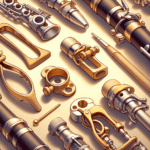The art of playing the clarinet can be greatly improved by the tools you select, and one of the most crucial accessories for any clarinetist is the ligature. The ligature significantly influences how well your reed vibrates and, as a result, how your instrument sounds. For professionals, grasping the distinctions between ligature types can boost performance and personal expression.
What is a Clarinet Ligature?
A clarinet ligature is a device that secures the reed to the mouthpiece while enabling controlled vibration. This device's interaction with the reed can notably affect tone quality, response, and overall playability. For professional musicians, ligature selection often boils down to personal preference based on playing style, music genre, and desired sound.
Types of Ligatures
Today's clarinet ligatures come in various styles, each with unique features suited to different playing styles. Let's explore the main types:
| Ligature Type | Material | Sound Characteristics | Best For |
|---|---|---|---|
| Metal | Brass, silver, stainless steel | Focused, bright tone | Jazz, contemporary |
| Fabric | Cotton, leather | Warmer, richer tone | Classical, chamber music |
| Plastic | Various plastics | Balanced, less distinct | Beginners, practice |
| Hybrid | Combination of materials | Balanced brightness and warmth | Versatile performers |
Choosing the Right Ligature
Several factors come into play when picking the ideal ligature for your clarinet:
- Sound Preference: Jazz band performances might benefit from a more focused and bright sound. On the other hand, classical musicians often lean towards a warmer, more rounded tone.
- Playing Style: Ligatures offering greater reed flexibility can enhance the performance of those who prefer a more textural approach to tone. It's important to consider how each ligature type complements your unique style.
- Reed Type: The material and thickness of your reed can also influence ligature performance. Thicker reeds might need a ligature with a stronger grip, while softer reeds could resonate better with less tension.
Maintenance and Care for Ligatures
Proper care of your ligature extends its lifespan and maintains sound quality:
- Cleaning: Use a soft, damp cloth to clean your ligature regularly, removing moisture and debris. Be extra careful with fabric and leather ligatures as they're more prone to damage.
- Storage: Keep your ligature in a protective case when not in use to prevent bending or warping. This ensures it maintains its shape and effectiveness.
- Inspection: Check your ligature regularly for signs of wear or damage. If you notice significant degradation, it might be time for a replacement.
Conclusion
For professional clarinet players, the choice of ligature can significantly impact the performance experience. The variations in sound and playability between different ligature types, while sometimes subtle, can be quite influential. By exploring these differences and trying out various options, you can discover the ligature that best complements your style and enhances your musical expression. Whether you're a classical musician aiming for warmth or a jazz player seeking brightness, you're sure to find a ligature that perfectly suits your needs.







